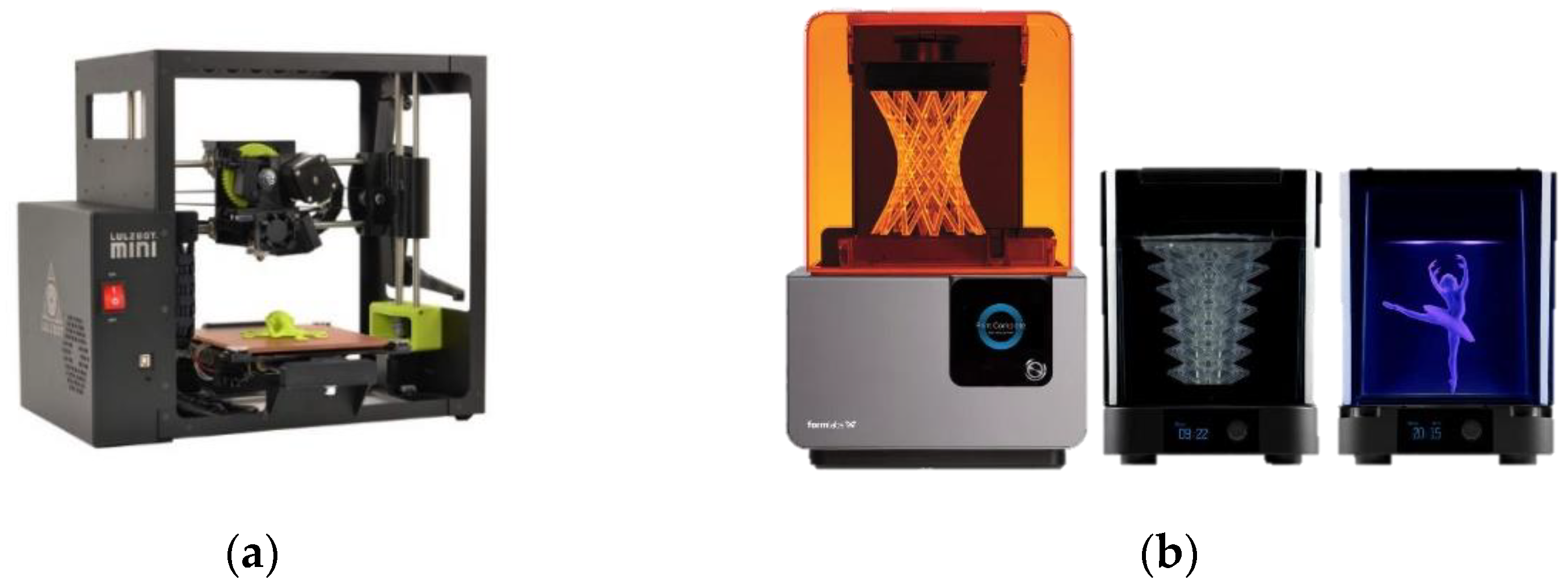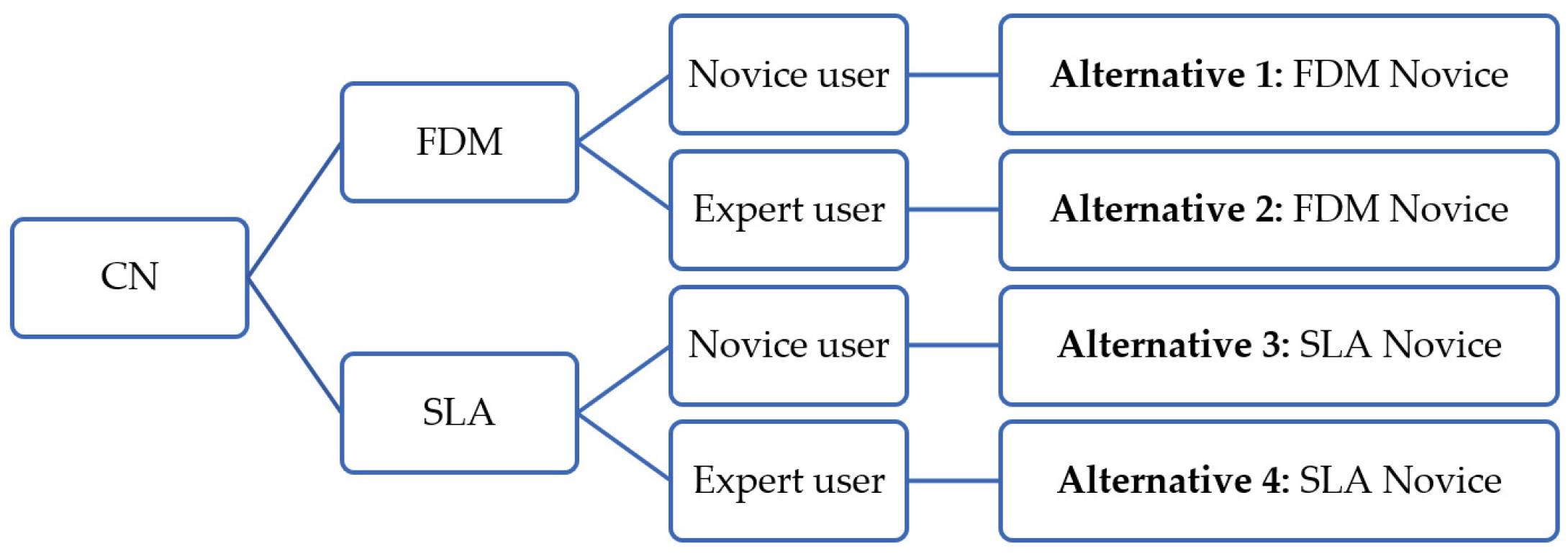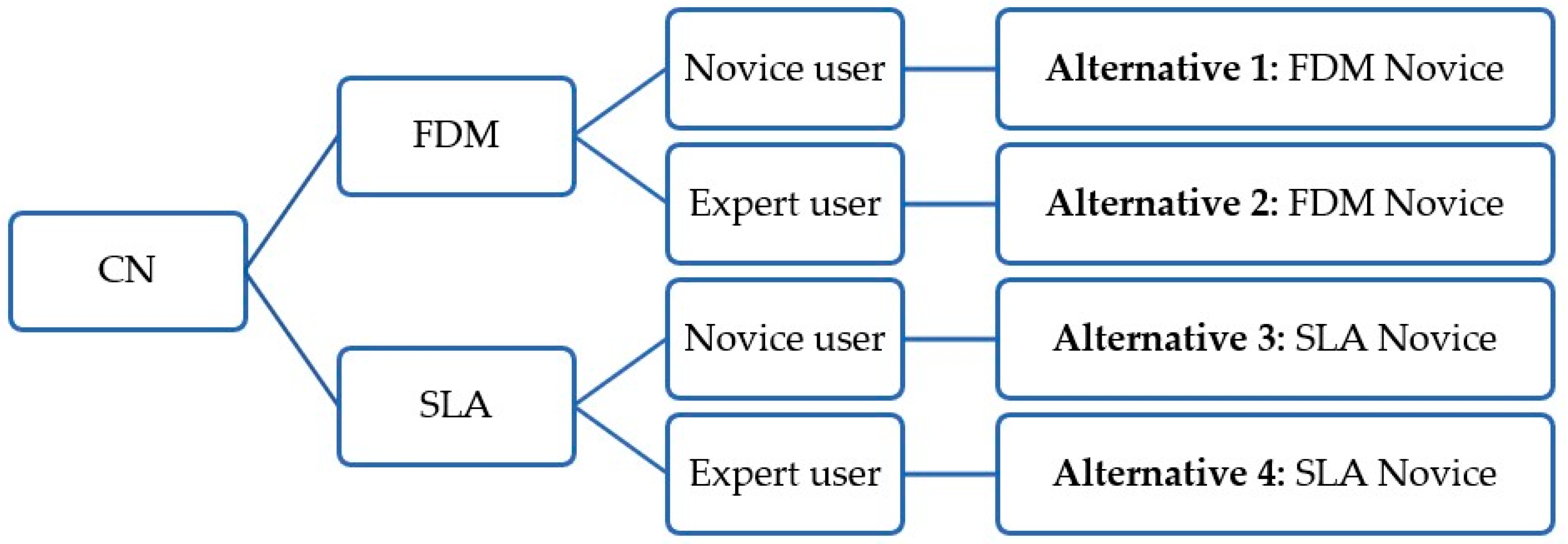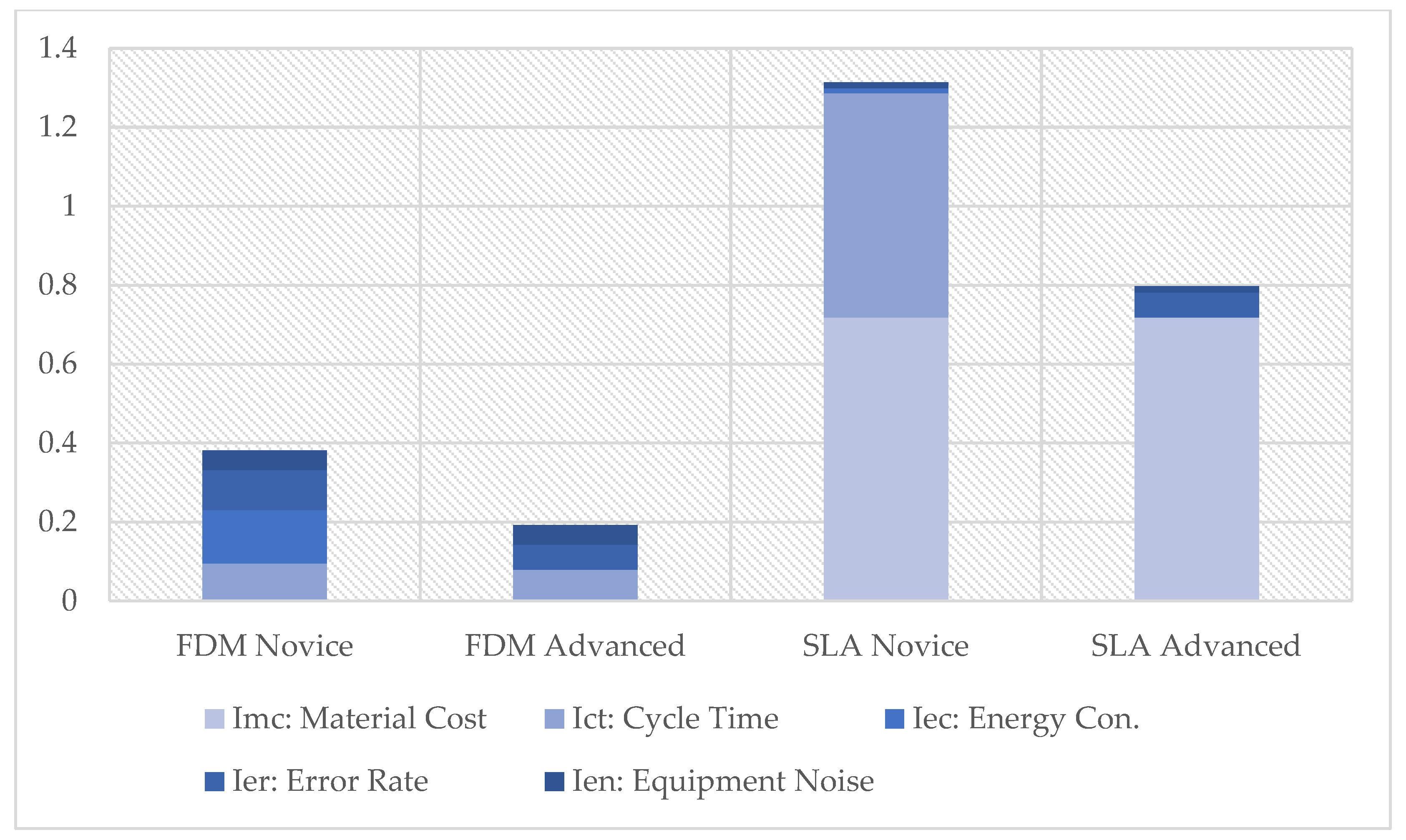A Hierarchical Axiomatic Evaluation of Additive Manufacturing Equipment and the 3D Printing Process Based on Sustainability and Human Factors
Abstract
1. Introduction
1.1. Theoretical Background
1.1.1. Axiomatic Design
1.1.2. Analytical Hierarchy Process
2. Materials and Methods
2.1. Materials
2.2. Participants
2.3. Limitations
2.4. Methodology
2.4.1. Stage 1: Define the Variables
2.4.2. Stage 2: Execute the Process
2.4.3. Stage 3: Evaluate the Criteria
2.4.4. Stage 4: Analyze the Results
2.4.5. Stage 5: Determine the Best Alternative
3. Results and Discussions
3.1. Material Cost
3.2. Cycle Time
3.3. Energy Consumption
3.4. Error Rate
3.5. Equipment Noise
4. Conclusions and Future Work
Author Contributions
Funding
Institutional Review Board Statement
Informed Consent Statement
Data Availability Statement
Acknowledgments
Conflicts of Interest
References
- Kumar, A. Methods and Materials for Smart Manufacturing: Additive Manufacturing, Internet of Things, Flexible Sensors and Soft Robotics. Manuf. Lett. 2018, 15, 122–125. [Google Scholar] [CrossRef]
- Zhong, R.Y.; Xu, X.; Klotz, E.; Newman, S.T. Intelligent Manufacturing in the Context of Industry 4.0: A Review. Engineering 2017, 3, 616–630. [Google Scholar] [CrossRef]
- Neumann, W.; Winkelhaus, S.; Grosse, E.H.; Glock, C.H. Industry 4.0 and the human factor—A systems framework and analysis methodology for successful development. Int. J. Prod. Econ. 2021, 233, 107992. [Google Scholar] [CrossRef]
- Prabhakar, M.M.; Saravanan, A.K.; Lenin, A.H.; Leno, I.J.; Mayandi, K.; Ramalingam, S. A short review on 3D printing methods, process parameters and materials. Mater. Today Proc. 2021, 45, 6108–6114. [Google Scholar] [CrossRef]
- Zakeri, S.; Vippola, M.; Levänen, E. A comprehensive review of the photopolymerization of ceramic resins used in stereolithography. Addit. Manuf. 2020, 35, 101177. [Google Scholar] [CrossRef]
- Sun, J.; Ye, D.; Zou, J.; Chen, X.; Wang, Y.; Yuan, J.; Liang, H.; Qu, H.; Binner, J.; Bai, J. A review on additive manufacturing of ceramic matrix composites. J. Mater. Sci. Technol. 2023, 138, 1–16. [Google Scholar] [CrossRef]
- Rasiya, G.; Shukla, A.; Saran, K. Additive Manufacturing—A Review. Mater. Today Proc. 2021, 47, 6896–6901. [Google Scholar] [CrossRef]
- Matias, E.; Rao, B. 3D printing: On its historical evolution and the implications for business. In 2015 Portland International Conference on Management of Engineering and Technology (PICMET); IEEE: New York City, NY, USA, 2015; pp. 551–558. [Google Scholar] [CrossRef]
- Jain, K.; Jain, K. Use of 3D printing for home applications: A new generation concept. Mater. Today Proc. 2021, 43, 605–607. [Google Scholar] [CrossRef]
- Laguna, O.H.; Lietor, F.; Godino, F.J.I.; Corpas-Iglesias, F.A. A review on additive manufacturing and materials for catalytic applications: Milestones, key concepts, advances and perspectives. Mater. Des. 2021, 208, 109927. [Google Scholar] [CrossRef]
- Ashima; Haleem, A.; Bahl, S.; Javaid, M.; Mahla, S.K.; Singh, S. Automation and manufacturing of smart materials in additive manufacturing technologies using Internet of Things towards the adoption of industry 4.0. Mater. Today Proc. 2021, 45, 5081–5088. [Google Scholar] [CrossRef]
- Biedermann, M.; Meboldt, M. Computational design synthesis of additive manufactured multi-flow nozzles. Addit. Manuf. 2020, 35, 101231. [Google Scholar] [CrossRef]
- Patwardhan, A. How 3D Printing Will Change the Future of Borrowing Lending and Spending? In Handbook of Blockchain, Digital Finance, and Inclusion; Elsevier: Amsterdam, The Netherlands, 2018; Volume 2, pp. 493–520. [Google Scholar] [CrossRef]
- Makanda, I.L.D.; Jiang, P. A Web-based Generative Process Planning System for FDM-based Additive Manufacturing. IFAC-PapersOnLine 2020, 53, 83–88. [Google Scholar] [CrossRef]
- Abisuga, O.A.; De Beer, D. A Systematic Literature Review and Prospects for the Additive Manufacturing in the Creative Industries. In Proceedings of the 13th AHFE International Conference on Additive Manufacturing, Modeling Systems and 3D Prototyping, New York, NY, USA, 24–28 July 2022. [Google Scholar]
- Khosravani, M.R.; Haghighi, A. Large-Scale Automated Additive Construction: Overview, Robotic Solutions, Sustainability, and Future Prospect. Sustainability 2022, 14, 9782. [Google Scholar] [CrossRef]
- Mecheter, A.; Tarlochan, F.; Kucukvar, M. A Review of Conventional versus Additive Manufacturing for Metals: Life-Cycle Environmental and Economic Analysis. Sustainability 2023, 15, 12299. [Google Scholar] [CrossRef]
- Sheehan; Joy, A.; Fleming, A.; Vosper, H.; McCarthy, S. Human factors and patient safety in undergraduate healthcare education: A systematic review. Human Factors Healthc. 2022, 2, 100019. [Google Scholar] [CrossRef]
- Moreno-Cabezali, B.M.; Fernandez-Crehuet, J.M. Application of a fuzzy-logic based model for risk assessment in additive manufacturing R&D projects. Comput. Ind. Eng. 2020, 145, 106529. [Google Scholar] [CrossRef]
- Xiong, Y.; Tang, Y.; Kim, S.; Rosen, D.W. Human-machine collaborative additive manufacturing. J. Manuf. Syst. 2023, 66, 82–91. [Google Scholar] [CrossRef]
- Reiman, A.; Kaivo-oja, J.; Parviainen, E.; Takala, E.-P.; Lauraeus, T. Human factors and ergonomics in manufacturing in the industry 4.0 context—A scoping review. Technol. Soc. 2021, 65, 101572. [Google Scholar] [CrossRef]
- Kadir, B.A.; Broberg, O.; da Conceição, C.S. Current research and future perspectives on human factors and ergonomics in Industry 4.0. Comput. Ind. Eng. 2019, 137, 106004. [Google Scholar] [CrossRef]
- Bikas, H.; Porevopoulos, N.; Stavropoulos, P. A decision support method for knowledge-based Additive Manufacturing process selection. Procedia CIRP 2021, 104, 1650–1655. [Google Scholar] [CrossRef]
- Song, R.; Telenko, C. Causes of Desktop FDM Fabrication Failures in an Open Studio Environment. Procedia CIRP 2019, 80, 494–499. [Google Scholar] [CrossRef]
- Zaman, U.K.U.; Rivette, M.; Siadat, A.; Mousavi, S.M. Integrated product-process design: Material and manufacturing process selection for additive manufacturing using multi-criteria decision making. Robot. Comput. Integr. Manuf. 2018, 51, 169–180. [Google Scholar] [CrossRef]
- Agrawal, R. Sustainable material selection for additive manufacturing technologies: A critical analysis of rank reversal approach. J. Clean. Prod. 2021, 296, 126500. [Google Scholar] [CrossRef]
- Kadkhoda-Ahmadi, S.; Hassan, A.; Asadollahi-Yazdi, E. Activity Modeling of Preliminary Additive Manufacturing Process Planning. Procedia CIRP 2019, 84, 874–879. [Google Scholar] [CrossRef]
- Yao, X.; Moon, S.K.; Bi, G. Multidisciplinary design optimization to identify additive manufacturing resources in customized product development. J. Comput. Des. Eng. 2017, 4, 131–142. [Google Scholar] [CrossRef][Green Version]
- Mahadik, A.; Masel, D. Implementation of Additive Manufacturing Cost Estimation Tool (AMCET) Using Break-down Approach. Procedia Manuf. 2018, 17, 70–77. [Google Scholar] [CrossRef]
- Telenko, C.; Seepersad, C.C. A comparison of the energy efficiency of selective laser sintering and injection molding of nylon parts. Rapid Prototyp. J. 2012, 18, 472–481. [Google Scholar] [CrossRef]
- Jennings, A. 3D Printing Troubleshooting: All Problems & Solutions. All3D. Available online: https://all3dp.com/1/common-3d-printing-problems-troubleshooting-3d-printer-issues/ (accessed on 8 January 2023).
- Ren, D.; Choi, J.-K.; Schneider, K. A multicriteria decision-making method for additive manufacturing process selection. Rapid Prototyp. J. 2022, 28, 77–91. [Google Scholar] [CrossRef]
- Pancha, U.; Dewa, M. Deployment of the analytic hierarchical process for comparative analysis of additive manufacturing technologies in the manufacture of injection moulds. South Afr. J. Ind. Eng. 2022, 32, 190–203. [Google Scholar] [CrossRef]
- Raja, S.; Rajan, A.J.; Kumar, V.P.; Rajeswari, N.; Girija, M.; Modak, S.; Kumar, R.V.; Mammo, W.D.; Gupta, P. Selection of Additive Manufacturing Machine Using Analytical Hierarchy Process. Sci. Program. 2022, 2022, 1–20. [Google Scholar] [CrossRef]
- Muvunzi, R.; Mpofu, K.; Daniyan, I. An Evaluation Model for Selecting Part Candidates for Additive Manufacturing in the Transport Sector. Metals 2021, 11, 765. [Google Scholar] [CrossRef]
- Laurenţiu, S.L.I.E.N.; Oana, D.O.U.; Margareta, C.O.E.; Valeriu, D.U.G.E.U.; Petru, D.U.; Felicia, B.A.C.U.; Irina, B.E.I. Selection of a Solution When Using Axiomatic Design. MATEC Web Conf. 2017, 127, 01019. [Google Scholar] [CrossRef]
- Weng, F.-T.; Jenq, S.-M. Application integrating axiomatic design and agile manufacturing unit in product evaluation. Int. J. Adv. Manuf. Technol. 2012, 63, 181–189. [Google Scholar] [CrossRef]
- Gölcük, İ. An interval type-2 fuzzy axiomatic design method: A case study for evaluating blockchain deployment projects in supply chain. Inf. Sci. 2022, 602, 159–183. [Google Scholar] [CrossRef]
- Palleti, V.R.; Joseph, J.V.; Silva, A. A contribution of axiomatic design principles to the analysis and impact of attacks on critical infrastructures. Int. J. Crit. Infrastruct. Prot. 2018, 23, 21–32. [Google Scholar] [CrossRef]
- Li, J.; Wu, X.; Zhang, X.; Song, Z.; Li, W. Design of distributed hybrid electric tractor based on axiomatic design and Extenics. Adv. Eng. Inform. 2022, 54, 101765. [Google Scholar] [CrossRef]
- Cavique, L.; Cavique, M.; Mendes, A.; Cavique, M. Improving information system design: Using UML and axiomatic design. Comput. Ind. 2022, 135, 103569. [Google Scholar] [CrossRef]
- Liu, A.-H.; Wan, S.-P.; Dong, J.-Y. An axiomatic design-based mathematical programming method for heterogeneous multi-criteria group decision making with linguistic fuzzy truth degrees. Inf. Sci. 2021, 571, 649–675. [Google Scholar] [CrossRef]
- Kulak, O.; Kahraman, C. Fuzzy multi-attribute selection among transportation companies using axiomatic design and analytic hierarchy process. Inf. Sci. 2005, 170, 191–210. [Google Scholar] [CrossRef]
- Aydoğan, S.; Günay, E.E.; Akay, D.; Kremer, G.E.O. Concept design evaluation by using Z-axiomatic design. Comput. Ind. 2020, 122, 103278. [Google Scholar] [CrossRef]
- Kumar, A.; Pant, S. Analytical hierarchy process for sustainable agriculture: An overview. MethodsX 2023, 10, 101954. [Google Scholar] [CrossRef] [PubMed]
- Singh, R.; Majumder, C.B.; Vidyarthi, A.K. Assessing the impacts of industrial wastewater on the inland surface water quality: An application of analytic hierarchy process (AHP) model-based water quality index and GIS techniques. Phys. Chem. Earth Parts A/B/C 2023, 129, 103314. [Google Scholar] [CrossRef]
- Sharma, A.; Hussain, V.M.S.; Kumar, A.; Pandit, M. Prioritization of forging die design criteria based on failure analysis using fuzzy analytic hierarchy process (FAHP). Mater. Today Proc. 2023, 80, 925–932. [Google Scholar] [CrossRef]
- Ozegin, K.O.; Ilugbo, S.O.; Ogunseye, T.T. Groundwater exploration in a landscape with heterogeneous geology: An application of geospatial and analytical hierarchical process (AHP) techniques in the Edo north region, in Nigeria. Groundw. Sustain. Dev. 2023, 20, 100871. [Google Scholar] [CrossRef]
- Yadav; Yadav, S.; Singh, D.; Kapoor, R.M.; Giri, B.S. An analytical hierarchy process based decision support system for the selection of biogas up-gradation technologies. Chemosphere 2022, 302, 134741. [Google Scholar] [CrossRef] [PubMed]
- Chaisar, M.; Garg, S.K. Selection of Sewage Treatment Technology using Analytic Hierarchy Process. Mater. Today Proc. 2022, 56, 3433–3440. [Google Scholar] [CrossRef]
- Panchal, S.; Shrivastava, A.K. Landslide hazard assessment using analytic hierarchy process (AHP): A case study of National Highway 5 in India. Ain Shams Eng. J. 2022, 13, 101626. [Google Scholar] [CrossRef]
- Shadmaan, S.; Islam, A.I. Estimation of earthquake vulnerability by using analytical hierarchy process. Nat. Hazards Res. 2021, 1, 153–160. [Google Scholar] [CrossRef]
- Lultzbot Mini. Fargo Additive Manufacturing Equipment 3D, LLC. Available online: https://lulzbot.com/store/lulzbot-mini (accessed on 8 January 2023).
- Form 2. FormLabs. Available online: https://formlabs.com/3d-printers/form-2/ (accessed on 8 January 2023).
- Post-Processing. FormLabs. Available online: https://formlabs.com/post-processing/ (accessed on 8 January 2023).
- Cura Lulzbot Edition. Fargo Additive Manufacturing Equipment 3D, LLC. Available online: https://lulzbot.com/support/cura (accessed on 8 January 2023).
- Formlabs Software. FormLabs. Available online: https://formlabs.com/software/ (accessed on 8 January 2023).
- FormLabs Draft V1 Resin Cartridge. Source Graphics. Available online: https://sourcegraphics.com/supplies/3d/formlabs/draft-resin/#:~:text=Supports%20print%20resolutions%3A%20300%20microns (accessed on 8 January 2023).
- Alsalaet, J.; Munahi, B.S.; Al-Sabur, R.; Al-Saad, M.; Ali, A.K.; Shari, B.A.; Fadhil, H.A.; Laftah, R.M.; Ismael, M. Laminar flowmeter for mechanical ventilator: Manufacturing challenge of COVID-19 pandemic. Flow. Meas. Instrum. 2021, 82, 102058. [Google Scholar] [CrossRef]
- Daher, R.; Ardu, S.; di Bella, E.; Krejci, I.; Duc, O. Efficiency of 3D-printed composite resin restorations compared with subtractive materials: Evaluation of fatigue behavior, cost, and time of production. J. Prosthet. Dent. 2024, 131, 943–950. [Google Scholar] [CrossRef]
- Patel, R.; Desai, C.; Kushwah, S.; Mangrola, M.H. A review article on FDM process parameters in 3D printing for composite materials. Mater. Today Proc. 2022, 60, 2162–2166. [Google Scholar] [CrossRef]
- Sénéchal, O. Maintenance decision support for sustainable performance: Problems and research directions at the crossroads of health management and eco-design. IFAC-PapersOnLine 2016, 49, 85–90. [Google Scholar] [CrossRef]
- Lundstrom, T.; Pugliese, G.; Bartley, J.; Cox, J.; Guither, C. Organizational and environmental factors that affect worker health and safety and patient outcomes. Am. J. Infect. Control 2002, 30, 93–106. [Google Scholar] [CrossRef] [PubMed]
- Raffish, N. How Much Does That Product Really Cost? Manag. Account. 1991, 72, 36. Available online: https://www.proquest.com/openview/9a7bae00b354b16c6d4f41328f58232f/1?cbl=48426&pq-origsite=gscholar&parentSessionId=X67x5NR0sMTpKuG%2BViU%2FcixBwkOjjNMcxaM61BSvqGk%3DP (accessed on 8 January 2023).
- Kahraman, C.; Cebi, S.; Onar, S.C.; Oztaysi, B. A novel trapezoidal intuitionistic fuzzy information axiom approach: An application to multicriteria landfill site selection. Eng. Appl. Artif. Intell. 2018, 67, 157–172. [Google Scholar] [CrossRef]
- Kulak, O.; Cebi, S.; Kahraman, C. Applications of axiomatic design principles: A literature review. Expert Syst. Appl. 2010, 37, 6705–6717. [Google Scholar] [CrossRef]
- Benavides, M. Axiomatic design. In Advanced Engineering Design; Elsevier: Amsterdam, The Netherlands, 2012; pp. 77–258. [Google Scholar] [CrossRef]
- Arrigo, R.; Frache, A. FDM Printability of PLA Based-Materials: The Key Role of the Rheological Behavior. Polymers 2022, 14, 1754. [Google Scholar] [CrossRef]
- Li, L.; Smith, D.M. Neural Efficiency in Athletes: A Systematic Review. Front. Behav. Neurosci. 2021, 15, e698555. [Google Scholar] [CrossRef]
- Deng, Y.; Chen, J.; Olechowski, A. What Sets Proficient and Expert Users Apart? Results of a Computer-Aided Design Experiment. J. Mech. Des. 2024, 146, 1–39. [Google Scholar] [CrossRef]
- Kariz, M.; Sernek, M.; Obućina, M.; Kuzman, M.K. Effect of wood content in FDM filament on properties of 3D printed parts. Mater. Today Commun. 2018, 14, 135–140. [Google Scholar] [CrossRef]
- Rogosic, R.; Poloni, M.; Marroquin-Garcia, R.; Dimech, D.; Jansen, J.P.; Cleij, T.J.; Eersels, K.; van Grinsven, B.; Diliën, H. Cost-effective, scalable and smartphone-controlled 3D-Printed syringe pump-From lab bench to point of care biosensing applications. Phys. Med. 2022, 14, 100051. [Google Scholar] [CrossRef]
- Xu, X.; Goyanes, A.; Trenfield, S.J.; Diaz-Gomez, L.; Alvarez-Lorenzo, C.; Gaisford, S.; Basit, A.W. Stereolithography (SLA) 3D printing of a bladder device for intravesical drug delivery. Mater. Sci. Eng. C 2021, 120, 111773. [Google Scholar] [CrossRef] [PubMed]
- Finnes, T. High Definition 3D Printing—Comparing SLA and FDM Printing Technologies. J. Undergrad. Res. 2015, 13, 10–26. Available online: https://openprairie.sdstate.edu/jur/vol13/iss1/3 (accessed on 8 January 2023).
- Song, R.; Telenko, C. Material and energy loss due to human and machine error in commercial FDM printers. J. Clean. Prod. 2017, 148, 895–904. [Google Scholar] [CrossRef]
- Suryatal, B.K.; Sarawade, S.S.; Deshmukh, S. Fabrication of medium scale 3D components using stereolithography system for rapid prototyping. J. King Saud. Univ.-Eng. Sci. 2023, 35, 40–52. [Google Scholar] [CrossRef]







| N | 1 | 2 | 3 | 4 | 5 | 6 | 7 | 8 | 9 | 10 |
|---|---|---|---|---|---|---|---|---|---|---|
| RI | 0 | 0 | 0.58 | 0.90 | 1.12 | 1.24 | 1.32 | 1.41 | 1.45 | 1.49 |
| Feature | Lulzbot Mini | Form2 |
|---|---|---|
| 3D printing technology | Fused deposition modeling | Stereolithography |
| Material | PLA and ABS | Draft V1 resin |
| Material consumption | 4–7 g | 7.13–7.30 mL |
| Fill density | 50–100% | 100% |
| Layer height | 250 microns (standard print) | 300 microns |
| Lulzbot Mini | Form2 |
|---|---|
| 1. Connect and turn on the printer | 1. Insert tank of resin, cleaner, and printing platform |
| 2. Turn on the computer and set up printing software | 2. Insert resin cartridge |
| 3. Connect and gain control of the printer | 3. Connect and turn on the printer |
| 4. Remove the filament | 4. Level the 3D printer |
| 5. Insert filament | 5. Turn on the computer and set up printing software |
| 6. Print | 6. Print |
| 7. Remove part from the printer | 7. Remove part from the printer |
| 8. Wash part | |
| 9. Cure part |
| Alternatives | C1: Material Cost (MXN/Part) | C2: Cycle Time (h) | C3: Energy Consumption (kwh) | C4: Error Rate (Events) | C5: Equipment Noise (db) |
|---|---|---|---|---|---|
| FDM Novice | 2.08–4.34 | 0.732–1.829 | 0.048–0.268 | 0–3 | 49.3–78.0 |
| FDM Advanced | 2.08–4.34 | 0.796–1.309 | 0.075–0.123 | 0–2 | 49.3–78.0 |
| SLA Novice | 20.32–20.80 | 1.589–2.264 | 0.061–0.139 | 0–1 | 57.0–72.3 |
| SLA Advanced | 20.32–20.80 | 1.448–1.709 | 0.069–0.095 | 0–2 | 57.0–72.3 |
| C1: Material Cost (MXN/Part) | C2: Cycle Time (h) | C3: Energy Consumption (kwh) | C4: Error Rate (Event) | C5: Equipment Noise (db) |
|---|---|---|---|---|
| 2.05–20.50 | 0.889–1.753 | 0.066–0.164 | 0–1 | 56.8–68.6 |
| Alternatives | Imc: Material Cost | Ict: Cycle Time | Iec: Energy Con. | Ier: Error Rate | Ien: Equipment Noise | ∑I |
|---|---|---|---|---|---|---|
| FDM Novice | 0 | 0.343 | 1.169 | 1.584 | 1.281 | 4.379 |
| FDM Advanced | 0 | 0.285 | 0 | 1 | 1.281 | 2.567 * |
| SLA Novice | 1.432 | 2.039 | 0.107 | 0 | 0.397 | 3.976 |
| SLA Advanced | 1.432 | 0 | 0 | 1 | 0.397 | 2.830 |
| Comparison | Expert A | Expert B | Expert C | Expert D | Average |
|---|---|---|---|---|---|
| C1–C2 | 0.333 | 3 | 5 | 5 | 3.333 |
| C1–C3 | 0.142 | 9 | 9 | 0 | 4.619 |
| C1–C4 | 9 | 5 | 7 | 7 | 7 |
| C1–C5 | 9 | 9 | 7 | 9 | 8.5 |
| C2–C3 | 0.142 | 7 | 9 | 0 | 4.119 |
| C2–C4 | 0.111 | 9 | 7 | 1 | 4.277 |
| C2–C5 | 9 | 9 | 7 | 9 | 8.5 |
| C3–C4 | 0.142 | 5 | 7 | 1 | 3.285 |
| C3–C5 | 0.111 | 0.111 | 9 | 1 | 2.555 |
| C4–C5 | 0.111 | 0.2 | 9 | 1 | 2.577 |
| Criteria | Material Cost | Cycle Time | Energy Consumption | Error Rate | Equipment Noise |
|---|---|---|---|---|---|
| Material cost | 1 | 3.333 | 4.619 | 7 | 8.5 |
| Cycle time | 0.3 | 1 | 4.119 | 4.277 | 8.5 |
| Energy con. | 0.216 | 0.242 | 1 | 3.285 | 2.555 |
| Error rate | 0.143 | 0.233 | 0.304 | 1 | 2.577 |
| Equipment noise | 0.117 | 0.117 | 0.391 | 0.387 | 1 |
| Criteria | Material Cost | Cycle Time | Energy Con. | Error Rate | Equipment Noise | w |
|---|---|---|---|---|---|---|
| Material cost | 0.563 | 0.676 | 0.443 | 0.436 | 0.367 | 49.8% |
| Cycle time | 0.169 | 0.203 | 0.395 | 0.268 | 0.367 | 28% |
| Energy con. | 0.122 | 0.049 | 0.095 | 0.206 | 0.111 | 11.7% |
| Error rate | 0.08 | 0.047 | 0.029 | 0.063 | 0.111 | 6.6% |
| Equipment noise | 0.066 | 0.024 | 0.038 | 0.024 | 0.043 | 3.9% |
| Principal Eigenvalue | Consistency Index | Consistency Ratio |
|---|---|---|
| 5.443 | 0.111 | 9.882% |
| Alternatives | Imc: Material Cost | Ict: Cycle Time | Iec: Energy Con. | Ier: Error Rate | Ien: Equipment Noise | ∑I |
|---|---|---|---|---|---|---|
| FDM Novice | 0 | 0.096 | 0.136 | 0.105 | 0.05 | 0.388 |
| FDM Advanced | 0 | 0.08 | 0 | 0.066 | 0.05 | 0.196 * |
| SLA Novice | 0.713 | 0.572 | 0.013 | 0 | 0.016 | 1.313 |
| SLA Advanced | 0.713 | 0 | 0 | 0.066 | 0.016 | 0.795 |
Disclaimer/Publisher’s Note: The statements, opinions and data contained in all publications are solely those of the individual author(s) and contributor(s) and not of MDPI and/or the editor(s). MDPI and/or the editor(s) disclaim responsibility for any injury to people or property resulting from any ideas, methods, instructions or products referred to in the content. |
© 2024 by the authors. Licensee MDPI, Basel, Switzerland. This article is an open access article distributed under the terms and conditions of the Creative Commons Attribution (CC BY) license (https://creativecommons.org/licenses/by/4.0/).
Share and Cite
Mendoza-Muñoz, I.; Montoya-Reyes, M.I.; Maldonado-Macías, A.A.; Jacobo-Galicia, G.; Vargas-Bernal, O.Y. A Hierarchical Axiomatic Evaluation of Additive Manufacturing Equipment and the 3D Printing Process Based on Sustainability and Human Factors. Processes 2024, 12, 1083. https://doi.org/10.3390/pr12061083
Mendoza-Muñoz I, Montoya-Reyes MI, Maldonado-Macías AA, Jacobo-Galicia G, Vargas-Bernal OY. A Hierarchical Axiomatic Evaluation of Additive Manufacturing Equipment and the 3D Printing Process Based on Sustainability and Human Factors. Processes. 2024; 12(6):1083. https://doi.org/10.3390/pr12061083
Chicago/Turabian StyleMendoza-Muñoz, Ismael, Mildrend Ivett Montoya-Reyes, Aidé Aracely Maldonado-Macías, Gabriela Jacobo-Galicia, and Olivia Yessenia Vargas-Bernal. 2024. "A Hierarchical Axiomatic Evaluation of Additive Manufacturing Equipment and the 3D Printing Process Based on Sustainability and Human Factors" Processes 12, no. 6: 1083. https://doi.org/10.3390/pr12061083
APA StyleMendoza-Muñoz, I., Montoya-Reyes, M. I., Maldonado-Macías, A. A., Jacobo-Galicia, G., & Vargas-Bernal, O. Y. (2024). A Hierarchical Axiomatic Evaluation of Additive Manufacturing Equipment and the 3D Printing Process Based on Sustainability and Human Factors. Processes, 12(6), 1083. https://doi.org/10.3390/pr12061083







